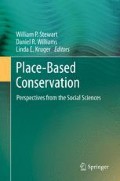Abstract
Relational marketing provides a framework for examining and preserving human relationships with landscapes, including place meanings. On the Flathead Indian Reservation in Montana, a Web-based mapping exercise allowed residents to locate and describe places that hold meaning for them, indicate the scale and intensity of those meanings, and characterize their perceptions of threats to these places. Here results are presented from a mapping exercise designed to facilitate group discussions with forest managers and the public regarding fuel treatments on tribally managed lands. The method built trust among tribal and non-tribal residents and improved fire planners’ understanding of relationships between proposed actions and place meanings.
Access this chapter
Tax calculation will be finalised at checkout
Purchases are for personal use only
References
Borrie, W. T., Christensen, N., Watson, A. E., Miller, T. A., & McCollum, D. W. (2002). Public purpose recreation marketing: A focus on the relationships between the public and public lands. Journal of Park and Recreation Administration, 20(2), 49–68.
Carver, S., Watson, A., Waters, T., Matt, R., Gunderson, K., & Davis, B. (2009). Developing computer-based participatory approaches to mapping landscape values for landscape and resource management. In S. Geertman & J. C. H. Stillwell (Eds.), Planning support systems best practice and new methods (pp. 431–448). Dordrecht, The Netherlands: Springer.
Dwyer, R. R., Schurr, P. H., & Oh, S. (1987). Developing buyer-seller relationships. Journal of Marketing, 55, 11–27.
Evans, A. J., & Waters, T. (2007). Mapping vernacular geography: web-based GIS tools for capturing “fuzzy” or “vague” entities. International Journal of Technology, Policy and Management, 7(2), 134–150.
Garbarino, E., & Johnson, M. S. (1999). The different roles of satisfaction, trust and commitment in customer relationships. Journal of Marketing, 63, 70–87.
Gunderson, K., & Watson, A. 2007. Understanding Place Meanings on the Bitterroot National Forest, Montana. Society & Natural Resources, 20(8), 705–721.
Lewis, J. L., & Sheppard, S. R. J. (2005). Ancient values, new challenges: Indigenous spiritual perceptions of landscapes and forest management. Society and Natural Resources, 18, 907–920.
Morgan, R. M., & Hunt, S. D. (1994). The commitment-trust theory of relationship marketing. Journal of Marketing, 58, 20–38.
Watson, A., & Borrie, W. (2006). Monitoring the relationship between the public and public lands: Application to wilderness stewardship in the U.S. In C. Aguirre-Bravo, P. J. Pellicane, D. P. Burn, & S. Draggan (Eds.), Monitoring science and technology symposium: Unifying knowledge for sustainability in the western hemisphere proceedings (pp. 287–293; RMRS-P-42CD). Fort Collins, CO: United States Department of Agriculture, Forest Service, Rocky Mountain Research Station.
Watson, A., Knotek, K., Matt, R., & Yung, L. (2007). Understanding landscape meanings, attributes, and threats for the planning and application of fuel treatment and fire management on the Flathead Indian Reservation, Montana. Report to the Confederated Salish & Kootenai Tribes. Missoula, MT: Aldo Leopold Wilderness Research Institute.
Watson, A., Matt, R., Knotek, K., Williams, D., & Yung, L. (2011). Traditional wisdom: Protecting relationships with wilderness as a cultural landscape. Ecology and Society, 16(1), 36. Retrieved from http://www.ecologyandsociety.org/.
Watson, A., Matt, R., Waters, T., Gunderson, K., Carver, S., & Davis, B. (2008). Mapping tradeoffs in values at risk at the interface between wilderness and non-wilderness lands. In A. Gonzalez-Caban (Ed.), Proceedings of the third international symposium on fire economics, planning, and policy: Common problems and approaches (pp. 375–387, PSW-GTR-22) Albany, CA: United States Department of Agriculture, Forest Service, Pacific Southwest Research Station.
Watson, A. E., & Borrie, W. T. (2003). Applying public purpose marketing in the USA to protect relationships with public land. In R. Buckley, C. Pickering, & D. B. Weaver (Eds.), Nature-based tourism, environment and land management (pp. 25–33). Wallingford, UK: CABI Publishing.
Author information
Authors and Affiliations
Corresponding author
Editor information
Editors and Affiliations
Rights and permissions
Copyright information
© 2013 Springer Science+Business Media Dordrecht
About this chapter
Cite this chapter
Watson, A., Carver, S., Matt, R., Waters, T., Gunderson, K., Davis, B. (2013). Place Mapping to Protect Cultural Landscapes on Tribal Lands. In: Stewart, W., Williams, D., Kruger, L. (eds) Place-Based Conservation. Springer, Dordrecht. https://doi.org/10.1007/978-94-007-5802-5_16
Download citation
DOI: https://doi.org/10.1007/978-94-007-5802-5_16
Published:
Publisher Name: Springer, Dordrecht
Print ISBN: 978-94-007-5801-8
Online ISBN: 978-94-007-5802-5
eBook Packages: Earth and Environmental ScienceEarth and Environmental Science (R0)

